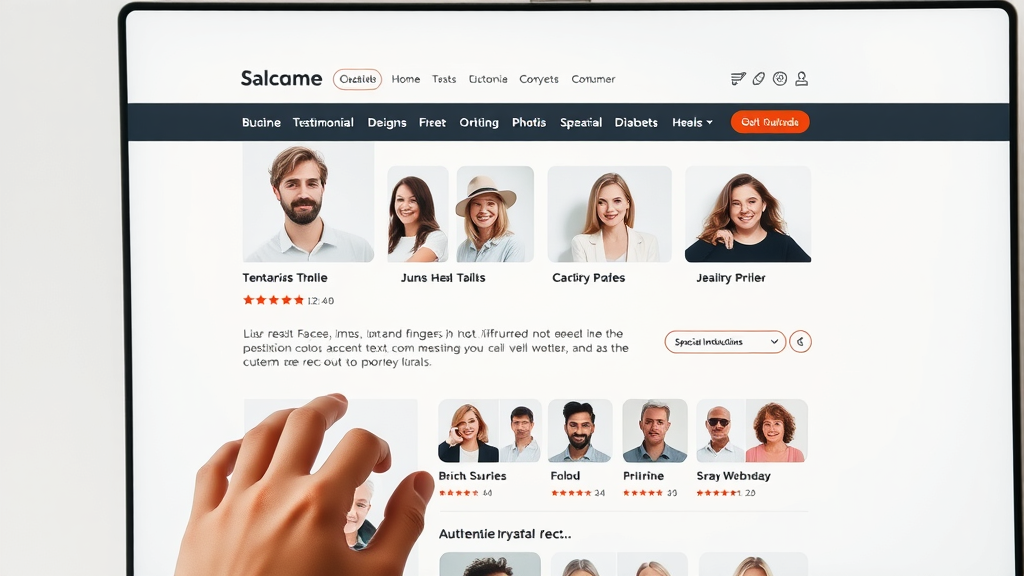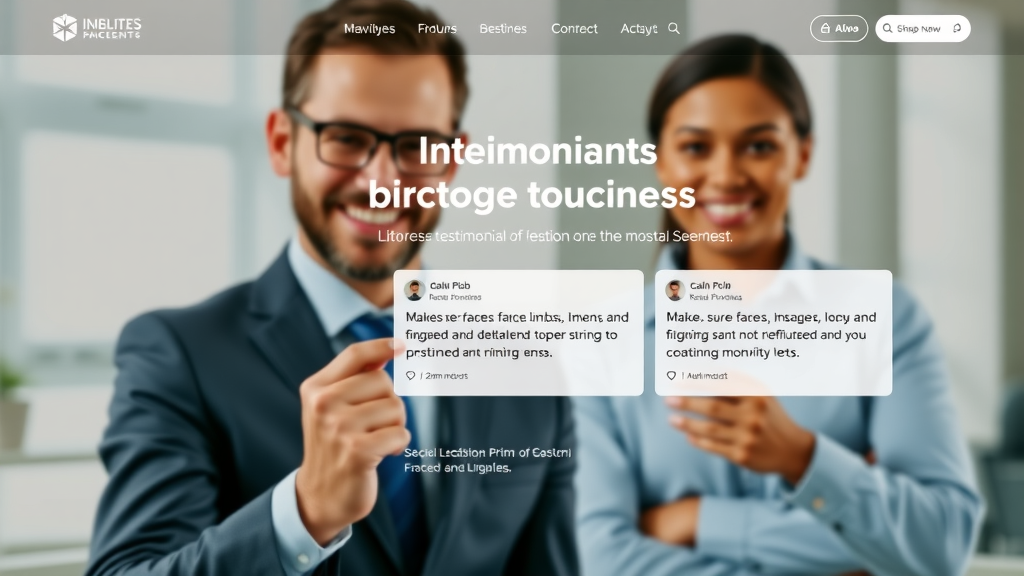Did you know that 92% of consumers trust user-generated content and testimonials more than traditional advertising? This isn’t just a quirky trend—it’s the new gold standard for driving conversions. Social proof isn’t just about bragging rights; it’s a science-backed approach to win over skeptical online shoppers and transform casual browsers into loyal customers. In today’s competitive digital landscape, smart brands harness customer voices to build trust, amplify credibility, and skyrocket conversion rates. Read on to learn exactly how you can turn testimonials and other forms of social proof into unstoppable conversion assets for your business.
Why Social Proof is the Secret Weapon for Online Success
In the noisy world of online marketing, simply showcasing an excellent product or service isn’t enough. The power of social proof lies in its ability to instantly boost credibility and build trust with potential customers. When shoppers see others publicly endorse a brand or product—through user reviews, customer testimonials, or social media shoutouts —they gain the reassurance that their purchase will be worthwhile. This psychological phenomenon, rooted in our natural human inclination to follow the behavior of peers, can dramatically increase conversions at every step of the buyer’s journey.
Let’s look at a few industry-shaking statistics: According to Nielsen, 70% of people trust recommendations from strangers online, making social proof one of the most persuasive factors in a consumer’s decision-making process. When it comes to testimonials specifically, studies show they can increase conversion rates by up to 34%. Even major brands like Amazon and Airbnb attribute much of their growth to real customer reviews and public evidence of satisfied buyers. Harnessing the power of social proof gives your brand the credibility it needs to stand out from the competition and turn interest into action.
Ultimately, customer testimonials shape buyer confidence and eliminate doubts. When you reveal the positive experiences of others, you tap into the collective trust of a community. This makes your potential customers far more likely to click “buy,” subscribe, or reach out—transforming testimonials into pure conversion gold.

- Discover industry-shaking statistics on social proof's effects
- Understand how testimonials shape buyer confidence and increase conversions
- Explore how major brands utilize social proof to drive results
How Social Proof Works: Science & Psychology Behind Persuasion
The science of social proof goes far beyond surface-level trends. At its core, social proof is rooted in human psychology and our innate desire to belong. When making purchase decisions online, people often look for evidence and cues from others—especially when uncertainty is high. This effect, sometimes referred to as herd behavior, is one of the most potent psychological triggers marketers can use to influence decisions. By displaying user reviews, endorsements, or expert badges, businesses legitimize their offerings—and, most importantly, reduce hesitation among potential customers.
Psychologists have studied the power of social influence for decades, revealing why testimonials, star ratings, and user-generated content make such a difference. These persuasive elements help bridge the gap between skepticism and trust. When shoppers see others are happy, engaged, and benefiting from a product or service, their own barriers to purchase shrink significantly. The result? Conversion rates rise substantially , and customers feel better about their buying decisions—setting the stage for even more positive reviews to follow.
Robert Cialdini and the Psychology of Social Proof
Dr. Robert Cialdini , a legend in the world of behavioral psychology, identified social proof as one of six cornerstone principles of persuasion in his seminal book, “Influence.” According to Cialdini, people are heavily influenced by the actions and opinions of others, especially in situations where they feel unsure or lack expertise. In marketing, this translates to a powerful shortcut: if many others have endorsed a product or left positive customer reviews , new prospects are far more likely to follow suit.
Cialdini’s research highlights how simple triggers such as “Most Popular,” “Bestseller,” or “4.5-star average” can convert browsers into buyers. This is because humans are hardwired to seek safety in numbers. When you see a crowd gathered around a restaurant, or hundreds of verified reviews next to a product, you instinctively believe it must be a good choice. This “wisdom of the crowd” drives higher conversion rates and enhances brand trust instantly.
- Summary of Cialdini’s research and psychological triggers: We trust others’ choices, follow popular trends, and look for social cues under uncertainty.
- Why humans are wired to trust social proof: Our evolutionary need for safety and community primes us to trust group opinions and endorsements.

Types of Social Proof: From Testimonials to Influencer Marketing
Not all social proof is created equal. Businesses today can leverage a remarkable variety of types of social proof , each offering its own flavor of credibility, trust, and conversion power. From expert endorsements and celebrity shoutouts to everyday user-generated content and analytic badges, the modern marketer has a vast toolkit for amplifying authority and persuasiveness online.
Understanding which forms of social proof to use—and when—is critical for optimizing your marketing campaigns. Each type targets slightly different audience motivations, so combining several can maximize your chances of earning conversions, building trust, and differentiating from competitors.
Exploring the Types of Social Proof in Digital Marketing
Let’s break down the most impactful types of social proof seen in digital marketing today:
- Expert social proof: Endorsements or approval from recognized authorities in the field, like industry experts or credible review platforms.
- Celebrity social proof and influencer marketing: Public figures or digital influencers endorsing your brand to large, engaged audiences.
- User-generated content and customer testimonials: Real photos, videos, and written reviews shared by actual customers, amplifying authenticity.
- Wisdom of the crowd: Highlighting stats like “Over 10,000 sold,” or “Rated 4.8 stars by over 5,000 reviewers.”
- Social media badges and endorsements: Trusted signals such as “Verified by Facebook” or “Google Reviews.”

Influencer Marketing’s Role in Modern Social Proof
Influencer marketing has redefined how brands utilize social proof, turning trusted digital personalities into direct conversion levers. By partnering with influencers who resonate with their target market, brands leverage trust, familiarity, and authenticity at scale. Influencers often act as both advocates and product users, displaying the result of the product or service in action and sharing honest feedback on their social networks. This transparently connects your brand to their loyal followers, leading to exponential reach and credibility.
Numerous case studies demonstrate how influencer partnerships can supercharge conversion rates . For example, when a tech company collaborated with a respected gadget reviewer on YouTube, their conversion rate doubled within weeks. Success stories like these prove the compounding effect of combining testimonial-driven marketing with influencer endorsement and social media amplification.
- Leveraging trusted voices to boost brand credibility.
- Case studies: Influencers increasing conversion rates.
11 Proven Ways Social Proof Can Increase Conversions
If you’re ready to increase conversions and supercharge growth, here are 11 proven tactics for putting social proof to work on your site and in your campaigns. These actionable steps provide the framework for conversion-optimized design and messaging, whether you’re running an ecommerce business, launching a new SaaS tool, or building trust as a personal brand:
- Showcase real customer testimonials prominently. Pin authentic endorsements at the top of landing pages and key conversion points.
- Use review widgets and social media highlights. Add dynamic review snippets, Instagram posts, or tweets directly to your site.
- Display user-generated content on product pages. Enable customers to upload photos and stories alongside written reviews.
- Leverage ‘as seen on’ media mentions and awards. Display logos of press outlets, award badges, and recognition.
- Highlight number of users/customers/downloads. Quantify credibility: “1,000+ businesses trust us.”
- Add trust badges and third-party endorsements. Show security seals, certifications, and partner logos.
- Feature influencer partnerships. Share video shoutouts, testimonials, and co-branded content with influencers.
- Utilize case studies that illustrate proof work. Demonstrate how your solution delivers results through detailed stories and real outcomes.
- Share data-backed proof that your solution works. Display stats from usage data, studies, or third-party audits.
- Use behavioral signals (live sales notifications, etc.). Show real-time activity: “Someone in New York just bought this!”
- Display best-selling/popular products using analytics. Highlight hot trends to activate the psychological power of the crowd.

- Showcase real customer testimonials prominently
- Use review widgets and social media highlights
- Display user-generated content on product pages
- Leverage ‘as seen on’ media mentions and awards
- Highlight number of users/customers/downloads
- Add trust badges and third-party endorsements
- Feature influencer partnerships
- Utilize case studies that illustrate proof work
- Share data-backed proof that your solution works
- Use behavioral signals (live sales notifications, etc.)
- Display best-selling/popular products using analytics

How to Collect & Curate Authentic Social Proof
Genuine, credible testimonials and reviews are marketing gold, but how do you collect them at scale—and make sure they’re authentic? The process starts with being proactive: request honest customer reviews and quotes immediately after purchase, or once users have seen noticeable results. Reach out directly via email, text, or automated post-purchase flows to invite feedback, stories, and even photos or videos showcasing successful product use. Remember, the more natural and specific the testimonial, the greater its conversion impact.
It’s equally important to encourage easy sharing. Invite satisfied customers to leave reviews on their favorite social networks or tag your business in user-generated content, such as unboxing videos or before-and-after shots. You can ethically incentivize participation with discounts, loyalty points, or small rewards—just be transparent about your intentions and avoid pressuring for positive feedback. The best social proof is always truthful, verifiable, and easily attributable to real people.
Best Practices for Gathering Social Media Testimonials
To maximize the conversion power of social media testimonials, deploy these best practices:
- Requesting customer quotes and photos: Ask loyal buyers to share what they love about your product or service and, if possible, include a selfie or demonstration.
- Encouraging shareable reviews on social media: Make it simple for users to repost their reviews, tag friends, or use branded hashtags for greater reach.
- Ethically incentivizing user-generated content: Offer genuine, low-risk rewards (like 10% off next order) to thank contributors, always disclosing your incentive policies.
This approach creates a virtuous cycle: Social proof builds trust, which leads to higher conversions—sparking even more customers to share their success stories online.

The Role of Social Proof in Website Optimization
Your website’s layout can make or break the impact of social proof. Modern consumers are overwhelmed with choices and tend to scan web pages quickly before engaging deeper. To maximize your results, strategic placement of testimonials, reviews, and trust badges is crucial. Consider adding testimonials in homepage hero sections for an instant trust boost, or display customer stars and product reviews directly on product and service pages to increase the rate of making purchase decisions where it matters most. Leading platforms like Shopify and WordPress offer plugins that seamlessly integrate social proof into any sales funnel.
Just as important is highlighting user credibility on checkout and pricing pages —the stage where users make final purchase decisions. Landing pages and strategically placed pop-ups can reinforce trust at exactly the moment of action, reducing buyer hesitation and cart abandonment rates. Experiment with A/B testing to identify which placements yield the highest conversion rates for your unique audience.
Where to Place Social Proof on Your Site for Maximum Effect
- Homepage hero sections: Place customer testimonials or badges above the fold.
- Product and service pages: Show user-generated photos and reviews next to product info.
- Checkout and pricing pages: Add trust badges, customer quotes, and review aggregates near action buttons.
- Landing pages and pop-ups: Reinforce confidence at any touchpoint where visitors take action.
By mapping your social proof placement to key user journey milestones, you ensure your credibility boosts conversions when and where they count the most.

Measuring the Impact of Social Proof: Metrics & Analytics
No social proof strategy is complete without tracking its tangible business impact. The best way to demonstrate the power of social proof is to monitor key metrics on your analytics dashboard, focusing on conversion rate changes and site engagement. Whether you’re running a marketing campaign or optimizing your landing page, knowing what works helps you double down on high-performing strategies and refine your approach for maximum ROI.
Start by running A/B tests that place testimonials in different positions or formats on your site. Carefully monitor conversion rate, click-through rates on social proof elements, and engagement statistics on user reviews and social network badges. These insights will guide future campaigns and help you use social proof as a repeatable engine for business growth.
Essential KPIs for Tracking Social Proof Performance
- Conversion rate uplift after testimonial placement: Track the change in conversions before and after adding testimonials or reviews.
- Click-through rates for social proof elements: Measure how often users interact with badges, videos, or review carousels.
- Engagement statistics on social media posts: Analyze likes, shares, and comments on posts featuring testimonials or influencer endorsements.
- A/B testing results for social proof variations: Continuously experiment to determine which form of social proof works best for your audience.
Diligent metric tracking ensures your social proof investment translates into measurable conversion rate gains.

What Makes Social Proof Credible? Avoiding Pitfalls and Manipulation
While social proof is a powerful tool, its effectiveness depends entirely on authenticity and transparency. Consumers today are more skeptical than ever and can quickly spot fake reviews, staged testimonials, or manipulative tactics. To maintain trust and conversion momentum, your social proof must be verifiable, honest, and linked to real customers or independent sources. Avoid the temptation to post unverified testimonials, and always be clear about any incentives offered for reviews.
Building audience trust hinges on factual proof; use third-party platforms for review collection, invite transparent feedback, and make it easy for customers to validate endorsement claims. Remember, in the world of conversion optimization, trust is your most valuable currency—you can’t fake it for long.
- Ensuring authenticity and transparency
- Avoiding fake reviews and unverified testimonials
- Building audience trust with factual proof
“Social proof is the marketing equivalent of a standing ovation.” — Unnamed Marketing Thought Leader
“Testimonials can boost conversion rates by more than 34%.” — Growcode 2023 Study
Expert Strategies: Advanced Tactics for Next-Level Social Proof
- Incorporate video testimonials to humanize your brand: Video adds emotional resonance and showcases real users truly benefiting from your offerings.
- Leverage real-time data and behavioral pop-ups: Show urgency with notices like “Just Sold” or “17 people viewing now.”
- Collaborate with community and micro-influencers: Smaller, niche influencers often generate higher engagement and trust among their close-knit audiences.
| Form of Social Proof | Impact on Conversion Rates | Best-Use Scenario |
|---|---|---|
| Customer Testimonials | +20-34% | Homepage, product, checkout |
| Expert Endorsements | +15-25% | Service sites, SaaS, health |
| Influencer Partnerships | +18-30% | Social media, product launches |
| User Reviews & UGC | +10-28% | Product and service pages |
| Trust Badges | +8-14% | Checkout, cart, landing pages |
| Social Media Channel | Best Practices |
|---|---|
| Repost UGC, host story highlights, tag customers, use branded hashtags | |
| Pin top reviews, share testimonials in posts, run review-based ads | |
| Share case studies and professional endorsements, publish articles | |
| YouTube | Upload video testimonials, influencer reviews, before-after demos |
| Highlight tweet testimonials, retweet endorsements, use threads |
Video: How Social Proof Can Transform Your Business
- Highlights of top-performing social proof campaigns: Real-world examples across ecommerce, SaaS, and services.
- Real results and testimonials case study: How integrating UGC and influencer endorsements doubled sales for a niche brand in six months.
Video: Optimizing Social Proof on Your Website
- Walkthrough of key placement strategies: See how testimonial carousels, popups, and review badges drive more conversions.
- Before-and-after website conversion analysis: Visual proof that moving testimonials above the fold can increase engagement by 20% or more.
FAQ: Mastering Social Proof for Maximum Conversions
- Best practices for different types of social proof: Combine written, video, and statistical proof for maximum effect. Always attribute testimonials to real customers, and refresh reviews regularly.
- How often should I update testimonials? Aim for new content every 3-6 months to maintain relevance and signal ongoing success to potential customers.
- Are video testimonials more effective than text? Yes, they typically convey emotion, authenticity, and trust more directly, leading to higher conversion rates.
- How can small businesses leverage social proof? Focus on gathering authentic customer feedback and highlighting local partnerships or awards. Even a handful of genuine testimonials can significantly increase conversion rates.
- What are the ethical considerations in social proof marketing? Always ensure reviews are genuine and never pay for fake testimonials. Be transparent about incentives and disclose paid or sponsored reviews.
What is a social proof example?
- A widely recognized social proof example is the use of customer reviews displayed on product pages, such as Amazon's star rating and personalized customer testimonials. This taps into the collective opinion of buyers to influence new purchases.
What is social proof in persuasion?
- Social proof in persuasion refers to the psychological tendency for people to follow the actions of others, especially under uncertainty. Seeing others endorse or purchase a product motivates new customers to do the same, leading to increased conversions.
What is the principle of social proof?
- The principle of social proof, as described by Robert Cialdini, is that people look to the actions of others to determine their own behavior, especially in ambiguous situations. This principle is foundational for marketing, emphasizing the value of testimonials, reviews, and influencer endorsements.
What is social proof in dating?
- Social proof in dating involves demonstrating value through desirability cues, such as positive references, mutual friends, or visible popularity on apps. This increases perceived attractiveness and trust.
Boost Your Brand: Take Action with Social Proof Today
Ready to grow your business? Book your free marketing strategy session with our team today.
Implement these actionable social proof strategies now to unlock higher conversion rates, deeper customer trust, and sustainable growth for your brand—start turning testimonials into your most powerful marketing asset today.
To deepen your understanding of social proof and its impact on consumer behavior, consider exploring the following resources:
-
What is Social Proof? A Guide for Small Businesses discusses how social proof builds credibility and trust, and offers strategies for integrating it into your marketing efforts.
-
What Is Social Proof and How to Use It? provides an overview of different types of social proof and practical examples of their application in various contexts.
These articles offer valuable insights into leveraging social proof to enhance your marketing strategies and boost conversions.
 Add Row
Add Row  Add
Add 



Write A Comment